Yuyu Guo
Automatic Left Ventricular Cavity Segmentation via Deep Spatial Sequential Network in 4D Computed Tomography Studies
Dec 17, 2024



Abstract:Automated segmentation of left ventricular cavity (LVC) in temporal cardiac image sequences (multiple time points) is a fundamental requirement for quantitative analysis of its structural and functional changes. Deep learning based methods for the segmentation of LVC are the state of the art; however, these methods are generally formulated to work on single time points, and fails to exploit the complementary information from the temporal image sequences that can aid in segmentation accuracy and consistency among the images across the time points. Furthermore, these segmentation methods perform poorly in segmenting the end-systole (ES) phase images, where the left ventricle deforms to the smallest irregular shape, and the boundary between the blood chamber and myocardium becomes inconspicuous. To overcome these limitations, we propose a new method to automatically segment temporal cardiac images where we introduce a spatial sequential (SS) network to learn the deformation and motion characteristics of the LVC in an unsupervised manner; these characteristics were then integrated with sequential context information derived from bi-directional learning (BL) where both chronological and reverse-chronological directions of the image sequence were used. Our experimental results on a cardiac computed tomography (CT) dataset demonstrated that our spatial-sequential network with bi-directional learning (SS-BL) method outperformed existing methods for LVC segmentation. Our method was also applied to MRI cardiac dataset and the results demonstrated the generalizability of our method.
Local-Global Information Interaction Debiasing for Dynamic Scene Graph Generation
Aug 10, 2023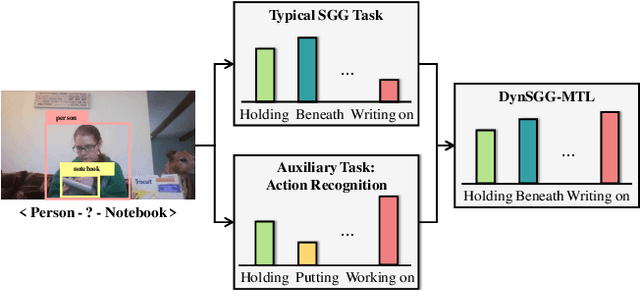

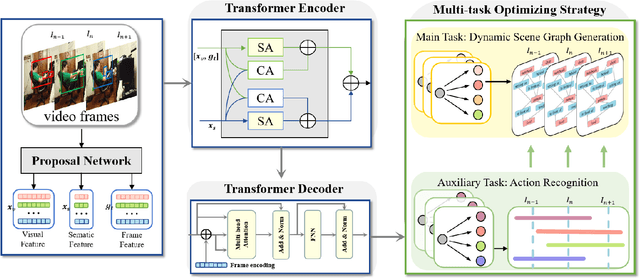
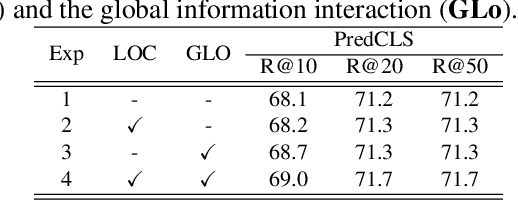
Abstract:The task of dynamic scene graph generation (DynSGG) aims to generate scene graphs for given videos, which involves modeling the spatial-temporal information in the video. However, due to the long-tailed distribution of samples in the dataset, previous DynSGG models fail to predict the tail predicates. We argue that this phenomenon is due to previous methods that only pay attention to the local spatial-temporal information and neglect the consistency of multiple frames. To solve this problem, we propose a novel DynSGG model based on multi-task learning, DynSGG-MTL, which introduces the local interaction information and global human-action interaction information. The interaction between objects and frame features makes the model more fully understand the visual context of the single image. Long-temporal human actions supervise the model to generate multiple scene graphs that conform to the global constraints and avoid the model being unable to learn the tail predicates. Extensive experiments on Action Genome dataset demonstrate the efficacy of our proposed framework, which not only improves the dynamic scene graph generation but also alleviates the long-tail problem.
Informative Scene Graph Generation via Debiasing
Aug 10, 2023Abstract:Scene graph generation aims to detect visual relationship triplets, (subject, predicate, object). Due to biases in data, current models tend to predict common predicates, e.g. "on" and "at", instead of informative ones, e.g. "standing on" and "looking at". This tendency results in the loss of precise information and overall performance. If a model only uses "stone on road" rather than "stone blocking road" to describe an image, it may be a grave misunderstanding. We argue that this phenomenon is caused by two imbalances: semantic space level imbalance and training sample level imbalance. For this problem, we propose DB-SGG, an effective framework based on debiasing but not the conventional distribution fitting. It integrates two components: Semantic Debiasing (SD) and Balanced Predicate Learning (BPL), for these imbalances. SD utilizes a confusion matrix and a bipartite graph to construct predicate relationships. BPL adopts a random undersampling strategy and an ambiguity removing strategy to focus on informative predicates. Benefiting from the model-agnostic process, our method can be easily applied to SGG models and outperforms Transformer by 136.3%, 119.5%, and 122.6% on mR@20 at three SGG sub-tasks on the SGG-VG dataset. Our method is further verified on another complex SGG dataset (SGG-GQA) and two downstream tasks (sentence-to-graph retrieval and image captioning).
Learning To Generate Scene Graph from Head to Tail
Jun 23, 2022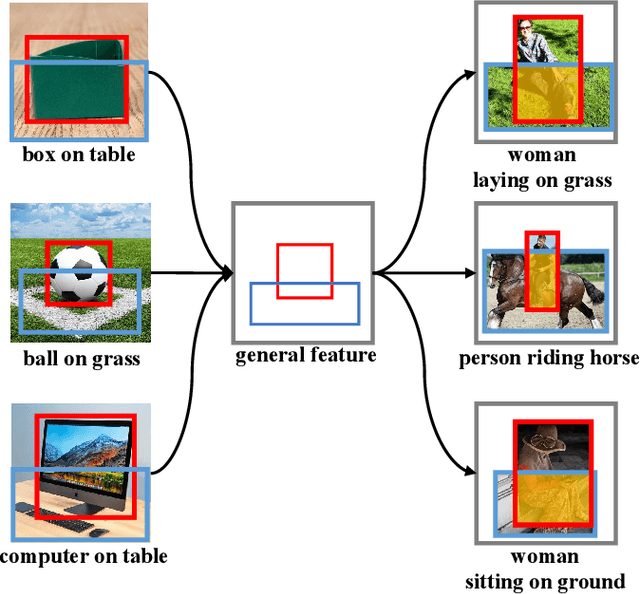
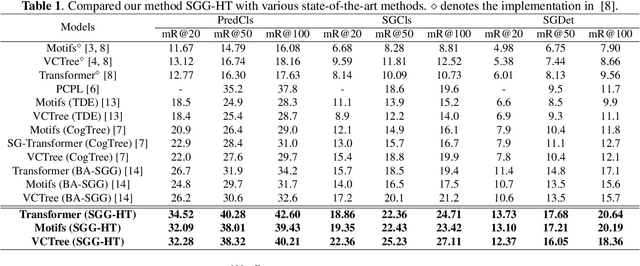
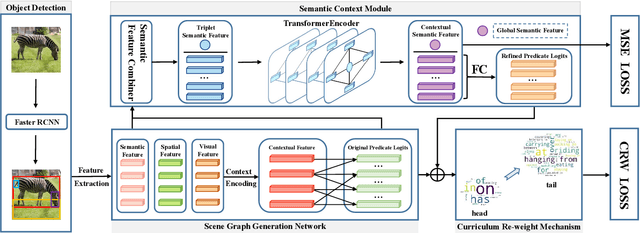
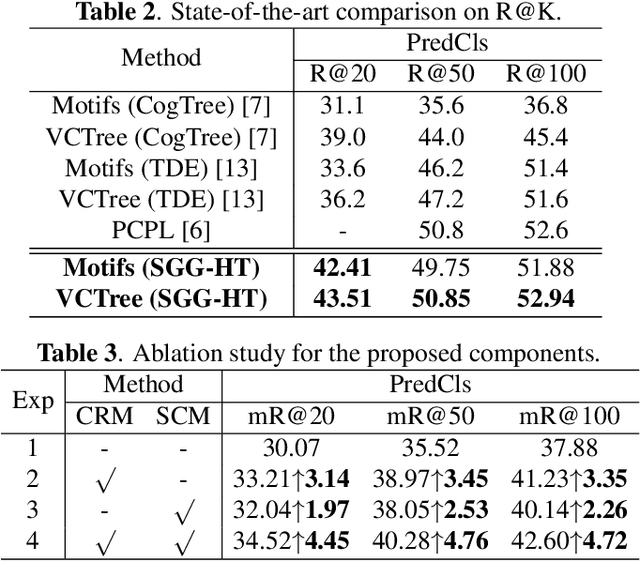
Abstract:Scene Graph Generation (SGG) represents objects and their interactions with a graph structure. Recently, many works are devoted to solving the imbalanced problem in SGG. However, underestimating the head predicates in the whole training process, they wreck the features of head predicates that provide general features for tail ones. Besides, assigning excessive attention to the tail predicates leads to semantic deviation. Based on this, we propose a novel SGG framework, learning to generate scene graphs from Head to Tail (SGG-HT), containing Curriculum Re-weight Mechanism (CRM) and Semantic Context Module (SCM). CRM learns head/easy samples firstly for robust features of head predicates and then gradually focuses on tail/hard ones. SCM is proposed to relieve semantic deviation by ensuring the semantic consistency between the generated scene graph and the ground truth in global and local representations. Experiments show that SGG-HT significantly alleviates the biased problem and chieves state-of-the-art performances on Visual Genome.
Fine-Grained Predicates Learning for Scene Graph Generation
Apr 08, 2022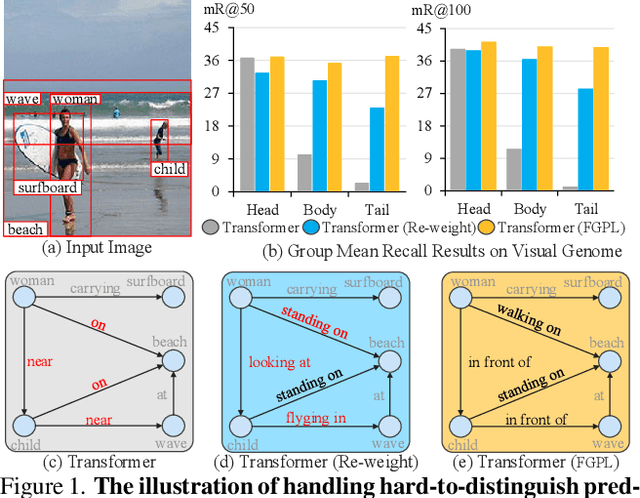

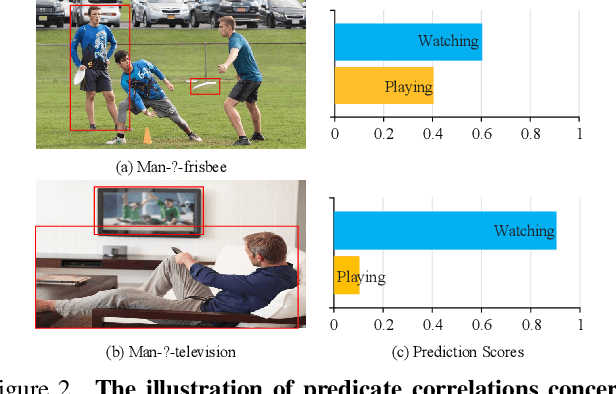

Abstract:The performance of current Scene Graph Generation models is severely hampered by some hard-to-distinguish predicates, e.g., "woman-on/standing on/walking on-beach" or "woman-near/looking at/in front of-child". While general SGG models are prone to predict head predicates and existing re-balancing strategies prefer tail categories, none of them can appropriately handle these hard-to-distinguish predicates. To tackle this issue, inspired by fine-grained image classification, which focuses on differentiating among hard-to-distinguish object classes, we propose a method named Fine-Grained Predicates Learning (FGPL) which aims at differentiating among hard-to-distinguish predicates for Scene Graph Generation task. Specifically, we first introduce a Predicate Lattice that helps SGG models to figure out fine-grained predicate pairs. Then, utilizing the Predicate Lattice, we propose a Category Discriminating Loss and an Entity Discriminating Loss, which both contribute to distinguishing fine-grained predicates while maintaining learned discriminatory power over recognizable ones. The proposed model-agnostic strategy significantly boosts the performances of three benchmark models (Transformer, VCTree, and Motif) by 22.8\%, 24.1\% and 21.7\% of Mean Recall (mR@100) on the Predicate Classification sub-task, respectively. Our model also outperforms state-of-the-art methods by a large margin (i.e., 6.1\%, 4.6\%, and 3.2\% of Mean Recall (mR@100)) on the Visual Genome dataset.
One-shot Scene Graph Generation
Feb 26, 2022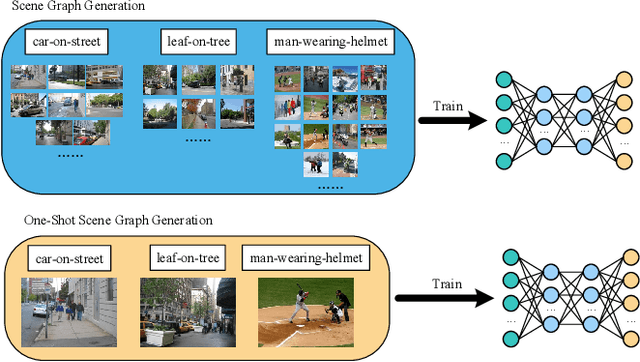

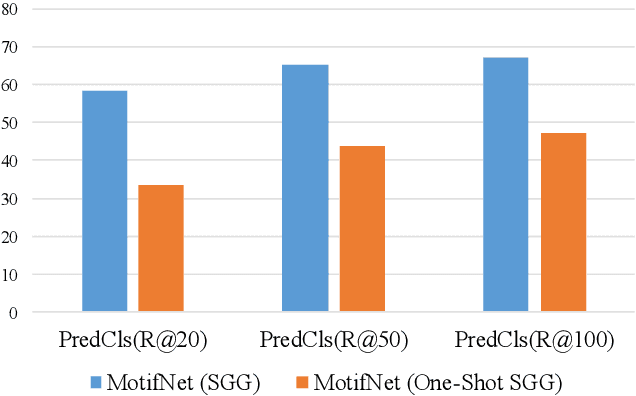
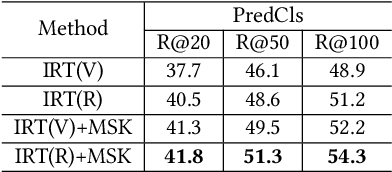
Abstract:As a structured representation of the image content, the visual scene graph (visual relationship) acts as a bridge between computer vision and natural language processing. Existing models on the scene graph generation task notoriously require tens or hundreds of labeled samples. By contrast, human beings can learn visual relationships from a few or even one example. Inspired by this, we design a task named One-Shot Scene Graph Generation, where each relationship triplet (e.g., "dog-has-head") comes from only one labeled example. The key insight is that rather than learning from scratch, one can utilize rich prior knowledge. In this paper, we propose Multiple Structured Knowledge (Relational Knowledge and Commonsense Knowledge) for the one-shot scene graph generation task. Specifically, the Relational Knowledge represents the prior knowledge of relationships between entities extracted from the visual content, e.g., the visual relationships "standing in", "sitting in", and "lying in" may exist between "dog" and "yard", while the Commonsense Knowledge encodes "sense-making" knowledge like "dog can guard yard". By organizing these two kinds of knowledge in a graph structure, Graph Convolution Networks (GCNs) are used to extract knowledge-embedded semantic features of the entities. Besides, instead of extracting isolated visual features from each entity generated by Faster R-CNN, we utilize an Instance Relation Transformer encoder to fully explore their context information. Based on a constructed one-shot dataset, the experimental results show that our method significantly outperforms existing state-of-the-art methods by a large margin. Ablation studies also verify the effectiveness of the Instance Relation Transformer encoder and the Multiple Structured Knowledge.
Exploiting long-term temporal dynamics for video captioning
Feb 22, 2022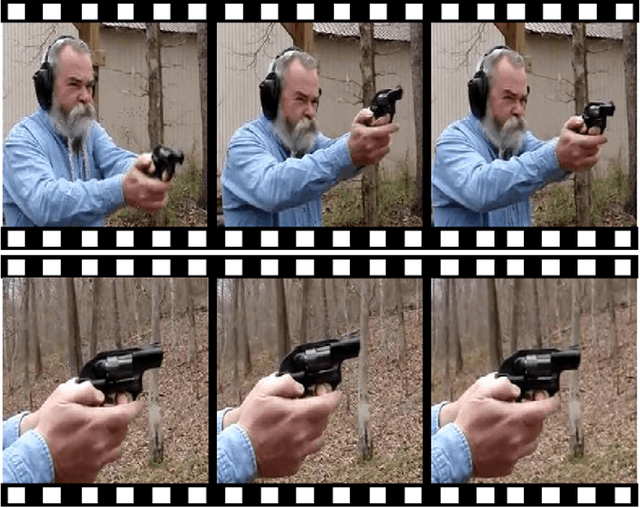

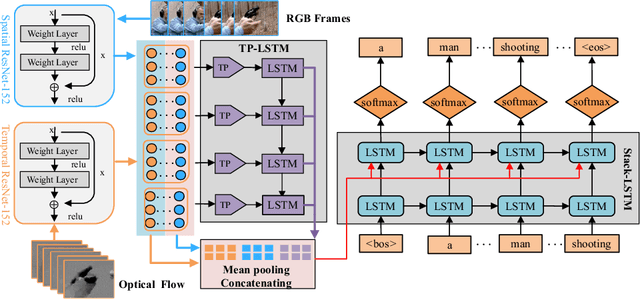

Abstract:Automatically describing videos with natural language is a fundamental challenge for computer vision and natural language processing. Recently, progress in this problem has been achieved through two steps: 1) employing 2-D and/or 3-D Convolutional Neural Networks (CNNs) (e.g. VGG, ResNet or C3D) to extract spatial and/or temporal features to encode video contents; and 2) applying Recurrent Neural Networks (RNNs) to generate sentences to describe events in videos. Temporal attention-based model has gained much progress by considering the importance of each video frame. However, for a long video, especially for a video which consists of a set of sub-events, we should discover and leverage the importance of each sub-shot instead of each frame. In this paper, we propose a novel approach, namely temporal and spatial LSTM (TS-LSTM), which systematically exploits spatial and temporal dynamics within video sequences. In TS-LSTM, a temporal pooling LSTM (TP-LSTM) is designed to incorporate both spatial and temporal information to extract long-term temporal dynamics within video sub-shots; and a stacked LSTM is introduced to generate a list of words to describe the video. Experimental results obtained in two public video captioning benchmarks indicate that our TS-LSTM outperforms the state-of-the-art methods.
Relation Regularized Scene Graph Generation
Feb 22, 2022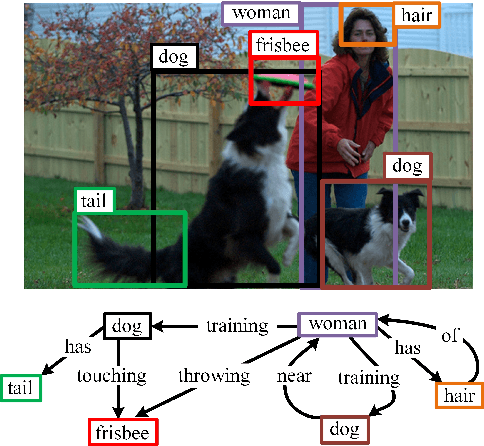
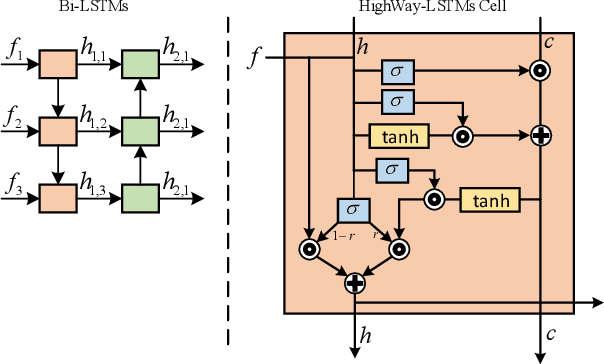
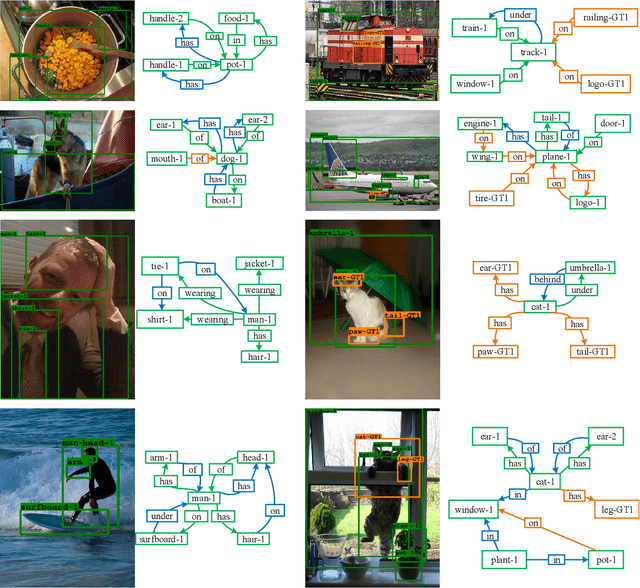
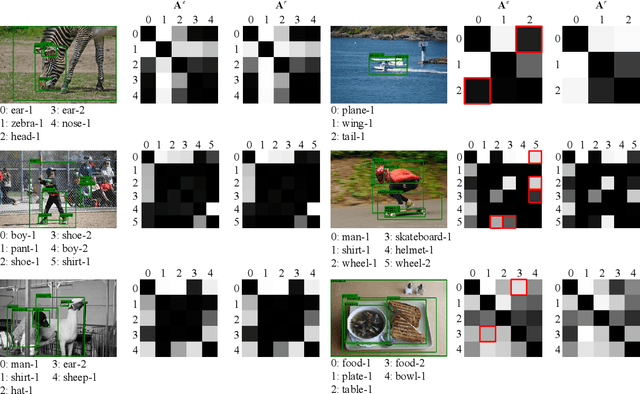
Abstract:Scene graph generation (SGG) is built on top of detected objects to predict object pairwise visual relations for describing the image content abstraction. Existing works have revealed that if the links between objects are given as prior knowledge, the performance of SGG is significantly improved. Inspired by this observation, in this article, we propose a relation regularized network (R2-Net), which can predict whether there is a relationship between two objects and encode this relation into object feature refinement and better SGG. Specifically, we first construct an affinity matrix among detected objects to represent the probability of a relationship between two objects. Graph convolution networks (GCNs) over this relation affinity matrix are then used as object encoders, producing relation-regularized representations of objects. With these relation-regularized features, our R2-Net can effectively refine object labels and generate scene graphs. Extensive experiments are conducted on the visual genome dataset for three SGG tasks (i.e., predicate classification, scene graph classification, and scene graph detection), demonstrating the effectiveness of our proposed method. Ablation studies also verify the key roles of our proposed components in performance improvement.
Unsupervised Landmark Detection Based Spatiotemporal Motion Estimation for 4D Dynamic Medical Images
Oct 12, 2021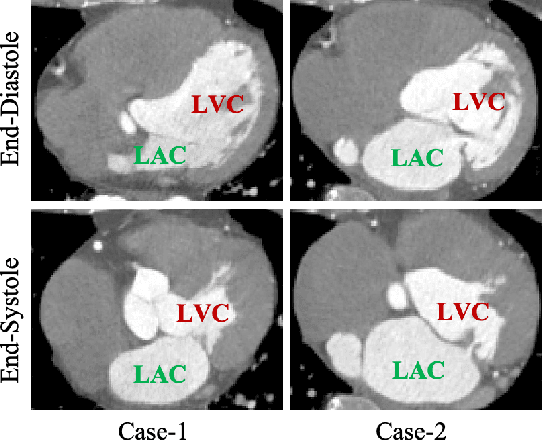
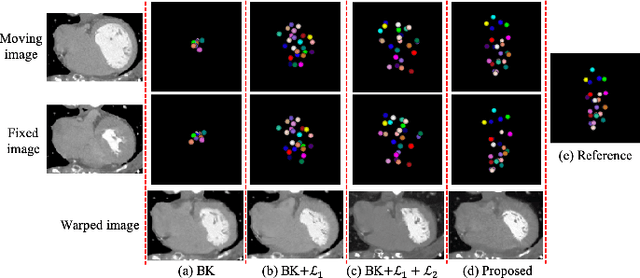
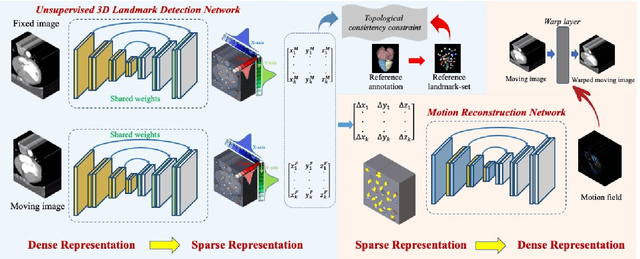
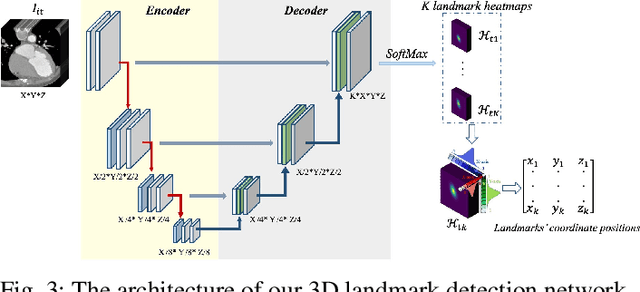
Abstract:Motion estimation is a fundamental step in dynamic medical image processing for the assessment of target organ anatomy and function. However, existing image-based motion estimation methods, which optimize the motion field by evaluating the local image similarity, are prone to produce implausible estimation, especially in the presence of large motion. In this study, we provide a novel motion estimation framework of Dense-Sparse-Dense (DSD), which comprises two stages. In the first stage, we process the raw dense image to extract sparse landmarks to represent the target organ anatomical topology and discard the redundant information that is unnecessary for motion estimation. For this purpose, we introduce an unsupervised 3D landmark detection network to extract spatially sparse but representative landmarks for the target organ motion estimation. In the second stage, we derive the sparse motion displacement from the extracted sparse landmarks of two images of different time points. Then, we present a motion reconstruction network to construct the motion field by projecting the sparse landmarks displacement back into the dense image domain. Furthermore, we employ the estimated motion field from our two-stage DSD framework as initialization and boost the motion estimation quality in light-weight yet effective iterative optimization. We evaluate our method on two dynamic medical imaging tasks to model cardiac motion and lung respiratory motion, respectively. Our method has produced superior motion estimation accuracy compared to existing comparative methods. Besides, the extensive experimental results demonstrate that our solution can extract well representative anatomical landmarks without any requirement of manual annotation. Our code is publicly available online.
From General to Specific: Informative Scene Graph Generation via Balance Adjustment
Aug 30, 2021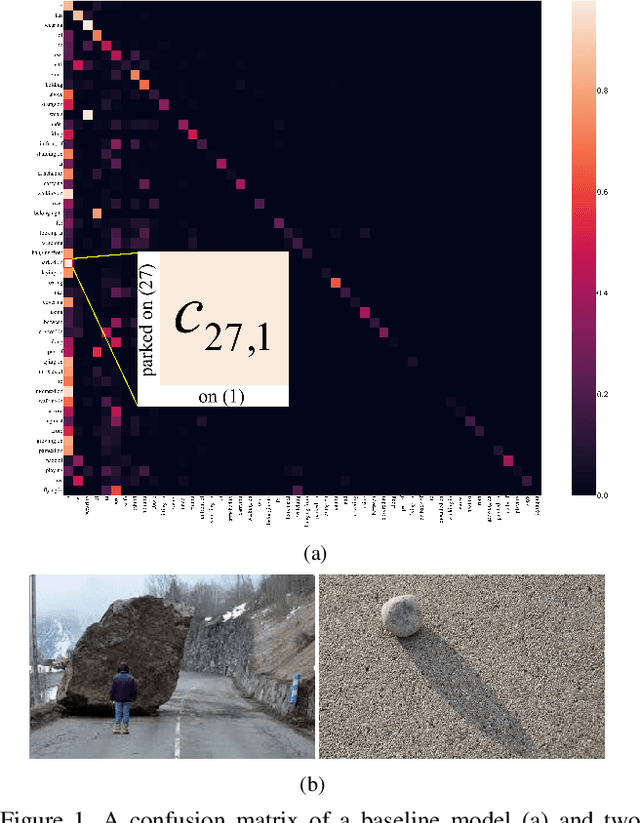



Abstract:The scene graph generation (SGG) task aims to detect visual relationship triplets, i.e., subject, predicate, object, in an image, providing a structural vision layout for scene understanding. However, current models are stuck in common predicates, e.g., "on" and "at", rather than informative ones, e.g., "standing on" and "looking at", resulting in the loss of precise information and overall performance. If a model only uses "stone on road" rather than "blocking" to describe an image, it is easy to misunderstand the scene. We argue that this phenomenon is caused by two key imbalances between informative predicates and common ones, i.e., semantic space level imbalance and training sample level imbalance. To tackle this problem, we propose BA-SGG, a simple yet effective SGG framework based on balance adjustment but not the conventional distribution fitting. It integrates two components: Semantic Adjustment (SA) and Balanced Predicate Learning (BPL), respectively for adjusting these imbalances. Benefited from the model-agnostic process, our method is easily applied to the state-of-the-art SGG models and significantly improves the SGG performance. Our method achieves 14.3%, 8.0%, and 6.1% higher Mean Recall (mR) than that of the Transformer model at three scene graph generation sub-tasks on Visual Genome, respectively. Codes are publicly available.
 Add to Chrome
Add to Chrome Add to Firefox
Add to Firefox Add to Edge
Add to Edge